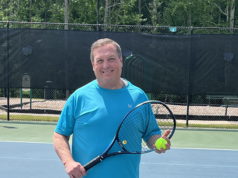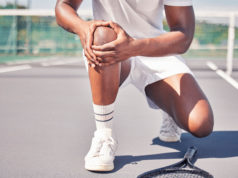Preventive treatment goes a long way in avoiding injury
By Richard C. Lehman, M.D., U.S. Center for Sports Medicine
Achilles tendonitis in tennis players is fairly common. This occurs most commonly in middle-aged players, with tight heel cords as a predisposition. Clay courts seem to help the condition, while hard courts seem to make the condition worse.
But let’s dial this back for a minute and talk about the Achilles tendon — what it is, where it is, and why tennis players have a predisposition to overload it. The Achilles tendon, which most people know is connected to the calf muscles, the two muscles known as the gastrocnemius and the soleus. These large muscles course downward toward your heel and connect to your calcaneus (heel bone). Because of the large pull of these muscles, there is a great deal of stress on the Achilles tendon. Most of this stress occurs when you serve, when you move forward toward the net, and when you sidestep. Also, when you are running out wide for a ball and are pushing off, the Achilles tendon is loaded with three to four times your body weight, creating significant stress in the Achilles. The Achilles tendon commonly has a decrease in blood supply as we get older. This is a reason that middle-aged tennis players are much more likely to develop overload of the tendon as it relates to the loss of blood supply compared with a younger player.
Don’t get me wrong: We do see Achilles tendon tears in young athletes, but the overload is much more commonly seen in older adults as our blood supply diminishes.
So what are the signs of Achilles tendonitis? They are pain and possibly swelling in the back part of your lower leg. It commonly occurs about 7 cm above your calcaneus. There may be a nodule in the back part of your Achilles tendon that makes pushing off quite painful. Additionally, when you sit for long periods of time and initially get up, this can be painful. However, once you start playing and are warmed up, there is increased blood supply to the Achilles and the soreness could resolve. But with an inflamed Achilles, once you are finished playing and are rested — perhaps having a post-match cocktail — and then you go to stand, the pain can be significant. If you are experiencing chronic pain or swelling in your Achilles, consult a physician.
Imaging for the Achilles tendon can include an x-ray and an MRI. If there is just a tendinopathy, or inflammation, or degeneration of the Achilles tendon, the treatment includes physical therapy and possibly a biologic. A biologic would be an injection of platelet rich plasma (PRP), with a combination of possibly stem cells. This treatment enhances the healing and increases the blood flow to the Achilles tendon and may allow improvement in healing of the degenerative area.
Other treatments include physical therapy on a manual basis. These are generally called Astym or Graston techniques. These techniques literally increase blood flow by manually breaking down the tendon. Surgery would be a last resort, and that would be to excise the necrotic component of the tendon if there is a partial tear and repair the healthy tendon so normal vascularity and normal tendon continuity is restored. We want to avoid surgery on the Achilles tendon if we possibly can because there is a lengthy rehabilitation process; it takes patients a long time to return to tennis.
How do we avoid Achilles tendonitis? First of all, Achilles tendonitis is caused by a number of factors, including the following:
- Poor tennis shoes.
- Lack of medial arch support.
- Tight Achilles tendon, which can be corrected with aggressive stretching and more importantly, aggressive warm up.
The lesson here would be to stretch, stretch, and stretch. Stretching just prior to playing tennis is not enough. Actually, stretching by itself is not enough.
It is important to stretch one or two times a day. It only takes 15 to 20 seconds and it is important to warm up thoroughly — that could be something as simple as riding an exercise bike, gentle stretching, doing a few light squats, anything that increases the blood flow to the Achilles tendon. It is crucial to warm up, stretch, and increase the blood flow in the calf prior to playing and again after your match. Consider doing squats, toe raises, or something as simple as jumping rope for 10 or 15 seconds. Preventive treatment goes a long way in avoiding Achilles tendonitis and avoiding recurrence of Achilles tendonitis. Nonsteroidal anti-inflammatories, such as ibuprofen and Naprosyn, are helpful. If the Achilles tendon gets sore, you want to do three things: You want to ice; you want to stretch; and you want to heat. And be sure to ice the area once more before going to bed. If your tendonitis persists for more than two weeks, see your doctor.
For more information, visit the U.S. Center for Sports Medicine at uscenterforsportsmedicine.com. The office phone number is 314.909.1666. If you have any questions, please call us directly.




